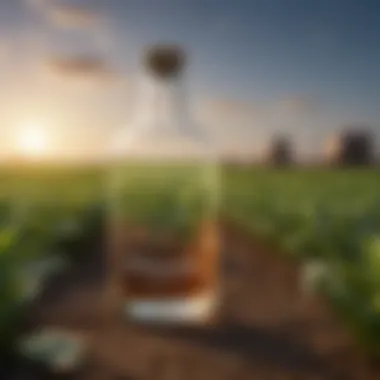Exploring Glufosinate: Impact and Use in Agriculture


Intro
Glufosinate is a herbicide that has garnered attention for its increasing use in agriculture, especially as farmers look for effective ways to manage weeds. This compound, a broad-spectrum herbicide, is not only valuable for its weed-killing properties but also raises crucial questions about its environmental safety. As we explore the various facets of glufosinate, we uncover its significance within the complex interplay of agricultural productivity and ecological health.
The ongoing discussions around glufosinate often delve into its mechanisms of action, where it inhibits an essential enzyme pathway in plants, thereby leading to their demise. Yet, while farmers appreciate the efficiency of glufosinate, researchers and environmental advocates caution about the potential repercussions on non-target species and soil health.
In this examination, we will consider numerous elements, including the chemical properties of glufosinate, its usage patterns, and the regulatory landscape surrounding its application. By diving deep into these topics, we aim to furnish readers—ranging from students to seasoned professionals—with a rich understanding of this herbicide and its implications for sustainable agriculture.
Prelims to Glufosinate
Glufosinate holds significant weight in the realm of agriculture, playing a key role as a non-selective herbicide. Its prominence stems not only from its utility in combating a variety of weeds but also from the complex interactions it has with the environment and regulatory frameworks. Understanding glufosinate is essential for modern agricultural practices and environmental stewardship. This section aims to shed light on the history of its development, its chemical composition, and the implications tied to its usage.
History and Development
Glufosinate was originally discovered in the late 1970s when scientists were on the lookout for new herbicides that could assist in managing weed populations effectively. It was derived from a natural compound found in the bacterium Streptomyces viridochromogenes. The substance wasn’t marketed until the early 1990s, but its subsequent rise to fame is attributed to its effectiveness in controlling broadleaf weeds and certain grasses.
The herbicide’s journey from the lab to the fields reflects agricultural demands and the pressures of increasing crop yields while controlling pest populations. Early adoption primarily occurred in regions with intensive farming practices, leading to its incorporation in genetically modified crops designed for first-rate resistance to herbicides. However, this shift also ushered in debates concerning environmental safety and human health impacts, which continue to this day.
Chemical Composition
Chemically, glufosinate is known as (±)-2-amino-4-(hydroxymethylphosphinyl)butanoic acid. This rather complex name hints at its phosphinic acid structure, which underpins its mode of action.
- Molecular Formula: C41N2O4P
- Molecular Weight: 190.11 g/mol
As a systemic herbicide, glufosinate gets absorbed through the leaves and roots of plants, swiftly moving throughout the plant's tissue. Its primary function is to inhibit the function of the enzyme glutamine synthetase. This inhibition leads to an accumulation of ammonia, ultimately causing cellular damage and death in target plants. The implications of such a reaction extend beyond immediate weed control; they raise questions about the broader ecological balance and potential toxicity for non-target species.
"The effectiveness of glufosinate is matched by its complexity in terms of environmental impact, where the balance between agricultural efficiency and ecological preservation becomes critical."
The intricate details surrounding glufosinate's history and chemical makeup serve as a foundational understanding as we advance to explore its agricultural applications and potential environmental impacts.
Mechanism of Action
Understanding the mechanism of action of glufosinate is crucial in evaluating its role in agriculture and its environmental consequences. This section delves into how glufosinate operates at a molecular level to disrupt plant processes, subsequently affecting agricultural practices and ecological systems. The effectiveness of this herbicide largely depends on how well it inhibits amino acid synthesis in target plants and the broader implications of those actions on both crop yield and biodiversity.
Inhibiting Amino Acid Synthesis
Glufosinate functions primarily by interfering with the synthesis of essential amino acids within plants. This compound inhibits the enzyme glutamine synthetase, which plays a pivotal role in the nitrogen metabolism of plants. By blocking this enzyme, glufosinate disrupts the conversion of glutamate into glutamine, leading to an accumulation of toxic levels of ammonia in plant tissues.
The effects of this inhibition can be both immediate and delayed, varying significantly between plant species. For instance, sensitive crops may exhibit visible symptoms like wilting or chlorosis within a short time after application. This characteristic allows farmers to apply glufosinate precisely when needed, thereby enhancing the overall management of weeds. However, it poses risks as well:
- Nutrient Imbalance: The disruption caused by glufosinate can lead to nutrient deficiencies in weed species that manage to survive the initial application.
- Application Timing: Applying glufosinate at the wrong time may spur rapid regrowth of resilient weeds, making timing crucial for effective management.
This inhibition presents a dual-edged sword—effective weed control paired with the necessity for careful usage to avoid environmental damage.
Effects on Target Plants
When glufosinate is applied, its destructive impact on target plants is evident. The acute disruption of amino acid synthesis acts as an uninvited guest in the life cycle of the plant, halting growth processes critical for development and reproduction. Notably, the timing of application relative to the plant's growth stage can significantly influence overall effectiveness.
- Early Growth Stages: The impact tends to be more pronounced during the early growth phases, where the plants have not yet built resilience against biochemical disruptions.
- Resistant Varieties: However, advancements in agricultural breeding have produced varieties that exhibit some resistance to glufosinate. These plants may possess traits that allow them to withstand certain inhibitors, which could complicate weed management in the long run.
"The efficacy of glufosinate hinges on the delicate balance between effective application and the resilience of certain weed populations."
In summary, glufosinate's mode of action hinges on its ability to inhibit key plant processes. While it offers robust weed management, it's imperative to consider the ramifications of its use on the surrounding ecosystem. By honing in on both the benefits and potential hazards, we sit at a crossroads where agricultural practices must evolve with a greater understanding of ecological dynamics.
Application in Agriculture
The application of glufosinate in agriculture is a multifaceted topic that deserves careful consideration. As a non-selective herbicide, it plays a crucial role in crop management, helping farmers tackle the ever-looming threat of weeds that compete for resources alongside cultivated plants. However, understanding its usage patterns brings forth a broader context of both benefits and challenges that are essential for sustainable farming practices.
Crop Types Utilized
Glufosinate is employed across a wide range of crop types, reflecting its versatility. Many cash crops such as canola, cotton, and soybeans benefit from its application to control troublesome weeds. It's especially effective in transgenic crops, where genetic modifications enhance the plant’s resilience to herbicides.


Some specific crops where glufosinate proves instrumental include:
- Soybean: Particularly with genetically modified varieties that resist glufosinate, making weed control easier without harming the crop itself.
- Corn: It helps manage the weed population without necessitating higher vaporization or drift risks associated with other herbicides.
- Fruit and Vegetable Cultivations: In some cases, glufosinate has made its way into the post-emergence control of weeds in apple and potato crops, ensuring minimal competition during critical growth phases.
The ability to tailor its use to various crops means glufosinate is a tool in the agricultural toolbox aimed at maximizing yield while maintaining quality. This crop specificity is key, as not every herbicide is suited for every plant species.
Rates of Application
Determining the right rates for glufosinate application is pivotal in maximizing efficacy while minimizing environmental risks. Farmers typically follow manufacturer guidelines, incorporating local agricultural advice based on their specific conditions.
- When applied at recommended rates, it efficiently targets weeds without causing substantial harm to crops.
- However, over-application can lead to serious consequences, such as soil toxicity or water runoff. It's essential to balance between effective weed control and maintaining a healthy ecosystem.
- Most growers use between one and three liters per hectare, depending on the weed pressure and crop stage.
Integration in Pest Management
In modern agriculture, glufosinate is not merely a standalone solution but integrates well into comprehensive pest management strategies. It can be used in conjunction with other herbicides as part of a rotational system to mitigate the development of herbicide-resistant weed populations.
This integrated approach involves:
- Using Multiple Modes of Action: Employing glufosinate alongside other herbicides can diversify the actions against different weed types and build resistance management.
- Timed Application: Seasonal timing can be optimized based on weed emergence patterns, where glufosinate application may best complement other pest management tactics.
- Customized Strategies: Each farm can develop specific methods that consider the unique environmental and economic circumstances, ensuring that the pest management strategy remains robust and adaptable.
"A well-rounded strategy that includes glufosinate must always account for local ecology and targeted pest characteristics to be truly effective."
Through thoughtful integration of glufosinate, farmers can bolster their efforts in sustainable agriculture, ensuring both economic viability and environmental stewardship. As the agricultural landscape evolves, the role of such herbicides will undoubtedly warrant close scrutiny and informed application.
Environmental Impact
Examining the environmental impact of glufosinate is crucial for understanding its role in modern agriculture. Given the increasing scrutiny over herbicide use, this section sheds light on several critical areas. Not only does it affect crop yield, but its long-term consequences can ripple through ecosystems. Recognizing these factors is essential for promoting sustainable agricultural practices and minimizing adverse effects.
Soil Health Considerations
Soil is the backbone of agricultural productivity, and glufosinate's interaction with it invites attention. This herbicide can have profound effects on soil microbiomes. Healthy soil teems with microorganisms that play vital roles, such as nutrient cycling and organic matter decomposition.
- Microbial Communities: Glufosinate can alter the abundance and diversity of these communities. For instance, studies show that prolonged application may lead to a decline in beneficial bacteria, negatively impacting soil structure and fertility.
- Nutrient Leaching: The herbicide's propensity to bind to soil particles can lead to nutrient leaching, especially in sandy soils. This risks reduced availability of essential nutrients like nitrogen and phosphorous, which are pivotal for plant growth.
Maintaining good soil health is paramount for sustainable farming, and understanding these impacts is key to mitigating risks.
Water Contamination Risks
Water sources are often at the mercy of agricultural practices. Glufosinate can migrate from fields into nearby waterways, introducing several environmental concerns.
The potential for herbicides to contaminate drinking water supplies raises alarms among environmentalists and regulators alike.
- Runoff and Erosion: Rainfall and irrigation can drive glufosinate beyond its intended target area. When this happens, it can enter rivers, lakes, and groundwater.
- Toxicity to Aquatic Life: Such contamination poses risks not just to agriculture but also to aquatic ecosystems. Organisms like fish and amphibians can suffer from exposure, leading to decreased biodiversity and altered food chains.
Water quality monitoring becomes vital in areas where glufosinate is used, ensuring safe water supply for both human consumption and ecological health.
Impact on Non-target Species
The implications of glufosinate extend beyond crops, significantly affecting non-target species. This includes beneficial insects, pruners of weeds, and pollinators, which are crucial for maintaining healthy ecosystems.
- Bees and Pollinators: Research indicates that herbicides, including glufosinate, can impact bee behavior. Reduced foraging and impaired navigation may result from exposure, fuelling declines in pollinator populations, which are essential for fruit and vegetable crops.
- Birds and Mammals: Non-target plant species, which serve as food or habitat for various wildlife, may be affected. Loss of vegetation diversity can lead to declines in bird populations and other small mammals dependent on those plants.
In essence, while glufosinate is championed for its effectiveness in controlling weeds, its broader ecological footprints necessitate careful evaluation and management.
Regulatory Status
The regulatory status surrounding glufosinate represents a significant facet of its application and perception within the agricultural community. Understanding the rules and guidelines that govern its use is crucial not only for farmers but also for consumers and environmentalists alike. These regulations aim to ensure safety in application, mitigate any potential environmental impact, and protect public health. This section will delve into the global regulatory standards governing glufosinate and also explore some of the controversies that arise surrounding its regulation.
Global Regulatory Standards
Glufosinate has garnered global attention, leading various countries to establish regulatory frameworks that dictate its approval and usage in agriculture. The European Union stands out as one of the strictest regulators. Here, glufosinate is classified under the PPP (Plant Protection Product) legislation, which mandates rigorous studies demonstrating its safety and efficacy. Generally, approval is contingent on an extensive risk assessment including:
- Toxicology data: Detailed studies on the effects of glufosinate on human and animal health.
- Environmental impact assessments: Evaluations detailing its breakdown in soil and water, and any potential harm to non-target species.
- Residue monitoring: Regular checks on food products to ensure that glufosinate levels remain below legally acceptable limits.


In countries like the United States, the Environmental Protection Agency (EPA) regulates glufosinate under the Federal Insecticide, Fungicide, and Rodenticide Act (FIFRA). The EPA conducts a thorough risk assessment before granting approval for any pesticide. Similarly, in Canada, Health Canada's Pest Management Regulatory Agency takes an assessment approach to ensure that the use of glufosinate does not pose unreasonable risks to human health or the environment.
These global regulatory standards serve to create a framework that controls how glufosinate can be used, aiming to balance agricultural productivity with health and safety considerations.
Controversies in Regulation
While regulations are developed to protect health and the environment, glufosinate's approval and use have not been without controversy. A notable point of contention lies in the relation between industry-funded studies and independent research. Critics often argue that the studies conducted by manufacturers tend to downplay potential risks or adverse effects associated with glufosinate use. This raises questions about the integrity and objectivity of the data that regulators rely on for decision-making.
For instance, although glufosinate's approval in several countries is based on its efficacy in weed control, there are heated debates among scientists and activists about potential links between this herbicide and long-term health consequences.
"When regulations rely heavily on industry studies, we risk overlooking pertinent safety concerns that could have lasting implications for public health and ecosystems."
Additionally, discrepancies exist between US and EU standards, where glufosinate remains approved in the US despite stricter regulations and bans in Europe, often leading to discussions about policy consistency and the role of international agreements in pesticide approval frameworks.
Overall, while regulations aim to provide a safeguard, the ongoing debates highlight the complexity and necessity for constant reevaluation as new research surfaces and public awareness grows.
Safety and Toxicology
The exploration of safety and toxicology concerning glufosinate is crucial in understanding its implications not only for agricultural practices but also for human health and ecosystems. Evaluating the potential risks associated with this non-selective herbicide provides a clearer picture of its application in modern farming. Safety and toxicology dive into the prior research regarding exposure levels, environmental persistence, and the impact on living organisms.
Human Health Risks
When it comes to human health, the scrutiny surrounding glufosinate is multifaceted. Individuals involved in handling or applying the herbicide might be at risk of exposure. The routes of exposure mainly include inhalation, skin contact, and ingestion, particularly among farmworkers. Given that glufosinate affects a specific enzyme pathway, it is paramount to assess its toxicity potential.
Research indicates varying degrees of toxicological effects that could emerge from chronic exposure. Some studies suggest that high concentrations might be linked to neurological effects or skin irritations.
"Understanding human exposure to glufosinate is essential to ensure the safety of agricultural workers."
Furthermore, considering population segments such as children and pregnant women is vital, as they might be more vulnerable to toxic effects. Regulatory bodies consistently gather data and conduct risk assessments. The focused dialogue around safe thresholds highlights the ongoing necessity for rigorous monitoring and safety protocols.
Animal Toxicity Studies
Animal studies significantly contribute to our comprehending of glufosinate's toxicity profiles. Experiments primarily utilize rodents to assess how the herbicide interacts with biological systems. The findings from these studies often provide insights that help set regulatory standards for the compound.
Generally, the acute toxicity is relatively low; however, tests show that prolonged exposure could lead to varying adverse effects like reproductive toxicity or developmental impacts. Observations have also indicated that animals exposed to higher doses may experience weight loss and organ-specific damage.
- Key Findings from Animal Toxicity Studies:
- Low acute toxicity in adult animals
- Potential for reproductive and developmental effects
- Observable long-term health impacts from chronic exposure
Such results are crucial when policies are drafted. They guide the legislature on permissible usage rates and define comprehensive safety measures for human and animal health. Thus, understanding these dimensions of glufosinate enables stakeholders to balance agricultural productivity against health safety concerns effectively.
Resistance Management
Resistance management is a crucial aspect of using glufosinate in agricultural practices. As farmers increasingly rely on herbicides to control weed populations, the risk of developing resistance in target weed species becomes pronounced. This section elaborates on the implications of resistant weed species, the significant need for proactive resistance management strategies, and the benefits of maintaining a balanced approach to herbicide application.
Development of Resistant Weed Species
The emergence of resistant weed species represents one of the primary challenges in contemporary agriculture. When the same herbicides are used repeatedly, weeds can adapt over time. For instance, certain populations of common lambsquarters and giant ragweed have shown resistance to glufosinate. This adaptation leads to a situation where the herbicide becomes increasingly ineffective, requiring farmers to resort to higher doses or seek alternative treatments.
Several factors contribute to the development of resistant weed populations:
- Continuous Use: Regular application of glufosinate without rotation with other herbicides promotes selection pressure on weed species, allowing resistant individuals to thrive.
- Genetic Variation: Some weed species naturally exhibit a range of genetic traits. This diversity means that even a small fraction of the population might carry resistance genes, making it easier for these traits to propagate.
- Environmental Conditions: Favorable conditions for growth can also facilitate the spread of resistant individuals, as these plants may dominate in competitive environments.
This resistance can have long-term consequences; it compromises weed management strategies, reduces crop yields, and increases production costs. Such challenges underscore the necessity for effective resistance management within agricultural practices.
Strategies to Mitigate Resistance
To combat the threat of resistant weed species, farmers and agricultural specialists need to implement strategic resistance management practices. Here are several proven approaches:
- Herbicide Rotation: Alternating glufosinate with different classes of herbicides can effectively disrupt the selection pressure on weed populations. Using herbicides with different modes of action prevents weeds from becoming resistant.
- Integrated Weed Management (IWM): Combining cultural practices, such as crop rotation and cover cropping, with herbicide applications can lower weed competition effectively. This holistic approach reduces reliance on any single control method, thus mitigating resistance risk.
- Monitoring and Scouting: Regularly checking fields for weed populations can help identify any signs of herbicide failure early. Noticing resistant weeds can prompt adjustments in management practices before they become a larger issue.
- Use of Non-chemical Controls: Incorporating mechanical controls like tillage or manual weeding can help manage weed populations without additional reliance on chemical herbicides. These measures can effectively suppress resistant species while maintaining soil health.
- Educating Farmers: Providing training about resistance management strategies not only raises awareness but also empowers farmers to make informed decisions about their crop management practices. Collaborative initiatives among agricultural communities can lead to more sustainable practices across broader regions.
Effective resistance management strategies must emphasize proactivity and education to sustain the efficacy of herbicides like glufosinate.


By implementing these strategies, farmers can better protect their crops from the adverse effects of resistant weed species, ensuring the longevity of Effective use of glufosinate and promoting sustainable agricultural practices.
Alternative Herbicides
The exploration of alternative herbicides represents a pivotal context for understanding the balance between agricultural efficiency and ecological stewardship. As debates around the use of glufosinate become more pronounced, the need for viable alternatives has emerged as crucial for farmers, researchers, and environmental advocates alike. Alternative herbicides can provide solutions that mitigate some of the adverse effects associated with conventional chemical herbicides, offering a path towards sustainable agriculture without compromising crop productivity.
Comparative Effectiveness
When we consider the effectiveness of alternative herbicides, it’s essential to evaluate them not just on their ability to control weeds but also on their environmental impact. These herbicides can vary significantly in terms of modes of action, persistence in the environment, and selectivity towards target and non-target species. For example:
- Glyphosate: Known for its broad-spectrum efficacy, glyphosate inhibits a specific metabolic pathway that most plants and some microorganisms utilize.
- Diquat: A fast-acting herbicide that works by desiccating plant tissues. Its effectiveness can diminish under certain conditions, and it often requires a multi-application strategy to achieve desired results.
Each of these alternatives demonstrates varying degrees of effectiveness depending on the target weed species and environmental conditions. Farmers are often tasked with an intricate balancing act; they must consider not only the immediate weed management goals but also long-term effects on soil health, water quality, and biodiversity.
Cost Analysis
Analyzing the costs associated with alternative herbicides is another significant element of this discourse. The economics of herbicide use goes far beyond the direct price per gallon or kilogram; it encompasses factors such as labor, application frequency, and possible need for additional treatments. Some key considerations include:
- Initial Costs vs. Long-Term Benefits: While some alternatives may initially seem more expensive, their potential for reduced applications or increased soil health could make them more economical over time.
- Market Fluctuations: Prices for herbicides can fluctuate based on supply chains and market demand, thus impacting cost-effectiveness calculations. For instance, an increase in demand for organic herbicides might elevate their baseline costs, thereby affecting farmer choices.
- Regulatory Costs: Compliance with environmental regulations can also dictate costs. Alternatives that are eco-friendlier but require extensive documentation may raise operational expenses.
In summary, the discourse around alternative herbicides should incorporate a holistic view—considering both their comparative effectiveness against target species and the cost dynamics in agriculture. This approach ultimately promotes informed decision-making for agricultural practices that remain economically viable and environmentally conscious.
"Selecting the right herbicide is not merely an issue of efficacy; it’s about cultivating a partnership with the ecosystem."
As we further explore these alternatives, a comprehensive understanding will enable stakeholders to make choices that support sustainability while achieving necessary agricultural outcomes.
Future Research Directions
Future research into glufosinate is not just a matter of advancing agricultural practices, but it delves into the core of sustainable farming. As concerns regarding environmental health and safety grow, understanding and advancing research on glufosinate becomes paramount. This inquiry is critical in addressing the ongoing dialogue between enhancing crop yields and maintaining ecological balance. By focusing on innovative approaches and new technologies in herbicide development, farmers, scientists, and policymakers can work together to foster an agricultural environment that meets both food production and environmental stewardship goals.
Advancements in Herbicide Development
The landscape of herbicide development is constantly changing, and glufosinate is at the heart of many recent innovations.
- Biotechnology Integration: One exciting avenue of exploration is the integration of biotechnology in herbicide formulation. Recent advances include the development of genetically modified crops that are tolerant to glufosinate. This synergy not only enhances crop resilience but also reduces the likelihood of weed resistance.
- Nano-formulations: Research is also looking into the use of nanotechnology to create more effective formulations. These nano-encapsulated herbicides can improve the delivery and absorption rates, maximizing effectiveness while minimizing environmental impact. This approach holds the potential for lower application rates of glufosinate, considerably reducing its footprint on ecosystems while ensuring agricultural productivity.
- Alternative Modes of Action: Additionally, the industry is exploring herbicides with different modes of action. This is crucial, as it can help in effective weed management strategies, particularly in preventing the development of resistance among weed populations. Understanding how these new compounds interact with glufosinate may lead to more integrated pest management practices.
These advancements could play a crucial role in ensuring that glufosinate remains a viable option for weed control while reducing hazards associated with its use.
Impact Studies on Biodiversity
The intersection between herbicide use and biodiversity is a complex yet essential subject deserving of careful scrutiny. Glufosinate's broad-spectrum action raises questions about its ecological implications, particularly concerning non-target species.
- Species Assessment: Future research needs to focus on the impact of glufosinate on diverse communities within ecosystems, particularly pollinators like bees, various insect populations, and soil organisms. Understanding these relationships is key in gauging the herbicide's direct and indirect effects on biodiversity.
- Longitudinal Studies: Long-term studies tracking changes in species populations and ecosystem health in relation to glufosinate use can provide deep insights. Such studies can offer empirical evidence which would help regulate usage effectively and inform sustainable practices.
- Restorative Practices: Moreover, research into restorative practices—ways to rehabilitate areas affected by glufosinate and similar herbicides—could lead to improved outcomes in terms of biodiversity conservation. This could include identifying native species that can thrive in these restored environments.
"Understanding the multifaceted role of glufosinate in agriculture is crucial to crafting solutions that support both farmers and the environment."
Research in these areas serves as an essential linchpin that pulls together various strands of inquiry to shape a balanced approach to modern agricultural challenges.
End
The discussion surrounding glufosinate takes on pivotal importance, especially in light of its widespread incorporation into modern agricultural practices. The need to balance agricultural productivity with environmental accountability cannot be overstated. The stakes are high; if mismanaged, glufosinate can lead to soil and water degradation that can have long-lasting repercussions on ecosystems and human health. For those involved in agriculture, understanding these implications equates to recognizing the broader impact of their choices.
Summary of Findings
The article has aimed to unveil multiple dimensions of glufosinate, from its mechanism of action in inhibiting amino acid synthesis to its role in crop management strategies. Here’s a crunch of key points covered:
- Chemical Nature: Glufosinate is a non-selective herbicide that interferes with glutamine synthesis, proving effective against various target weeds.
- Environmental Concerns: Risks include soil health degradation and potential water contamination, harming aquatic life.
- Regulatory Framework: A patchwork of regulations exists globally, reflecting ongoing debates about its safety and environmental impact.
- Resistance Management: The evolution of resistant weed species poses a serious challenge in the sustainable use of glufosinate.
In summary, glufosinate presents a mixed bag of advantages and challenges, making its application a critical topic in agricultural dialogues.
Call for Balanced Approaches
Given the complexities associated with glufosinate’s use, a call for balanced approaches becomes essential. Stakeholders must consider multi-faceted strategies that prioritize both crop yield and ecological integrity. Here are some pertinent recommendations:
- Integrated Pest Management (IPM): Utilizing glufosinate as part of an IPM strategy can reduce dependency on chemical controls, integrating biological pest management practices.
- Research and Development: Investing in research focused on alternative herbicides or innovative farming techniques can present less risky options for maintaining soil health and biodiversity.
- Regulatory Revisions: Continual assessment of regulations can help adapt to new research findings and ensure the protection of non-target species.
Ultimately, as farmers and researchers face mounting pressures to feed a growing global population, a harmonious balance between technological advancement and ecological preservation will be the cornerstone of sustainable agriculture.
Making informed decisions based on comprehensive knowledge of glufosinate and its implications is not just beneficial but critical for the future of agricultural ecosystems.



